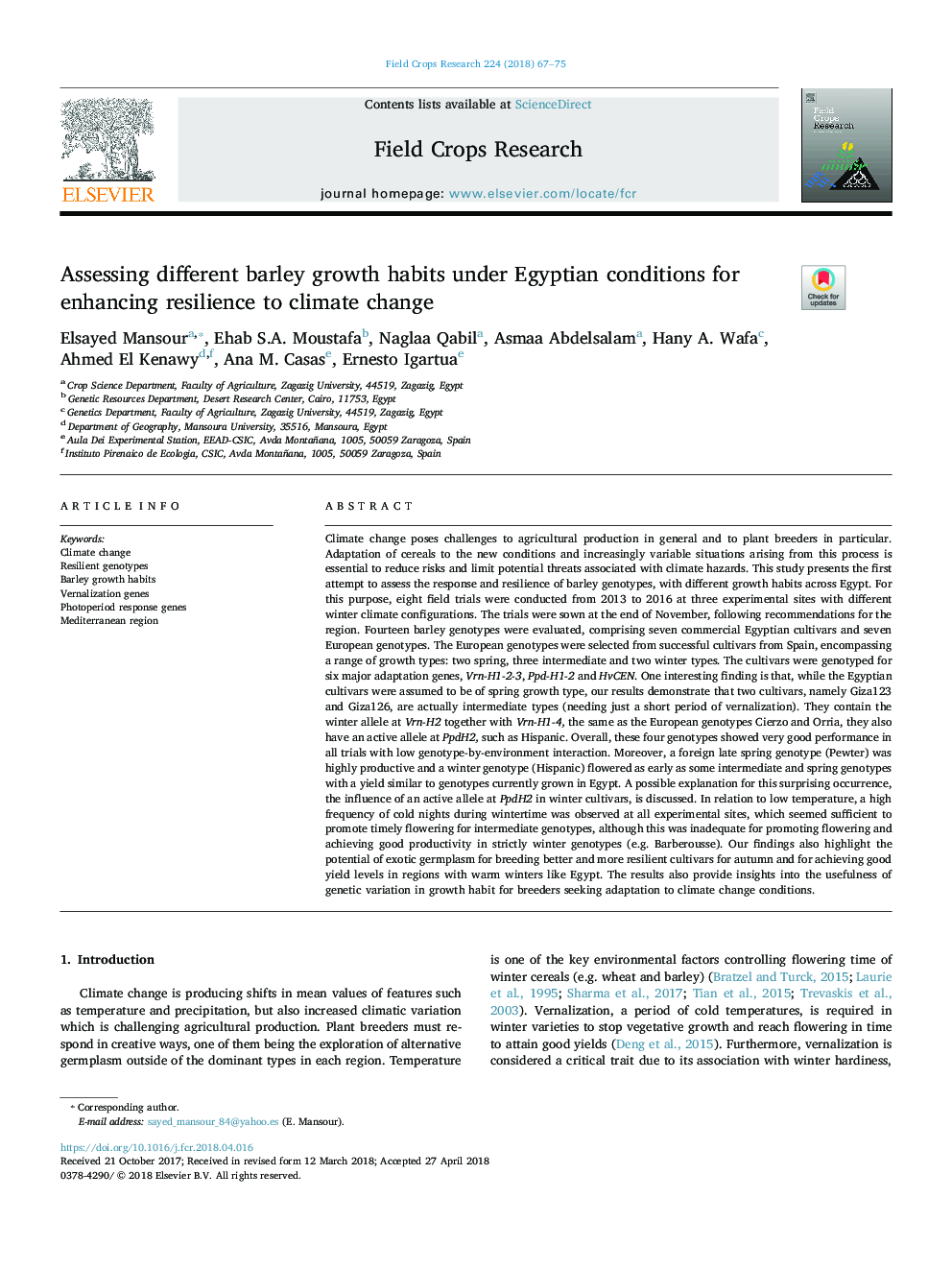| کد مقاله | کد نشریه | سال انتشار | مقاله انگلیسی | نسخه تمام متن |
|---|---|---|---|---|
| 8879117 | 1624639 | 2018 | 9 صفحه PDF | دانلود رایگان |
عنوان انگلیسی مقاله ISI
Assessing different barley growth habits under Egyptian conditions for enhancing resilience to climate change
ترجمه فارسی عنوان
ارزیابی عادت های مختلف جو در شرایط مصر برای افزایش مقاومت در برابر تغییرات
دانلود مقاله + سفارش ترجمه
دانلود مقاله ISI انگلیسی
رایگان برای ایرانیان
موضوعات مرتبط
علوم زیستی و بیوفناوری
علوم کشاورزی و بیولوژیک
علوم زراعت و اصلاح نباتات
چکیده انگلیسی
Climate change poses challenges to agricultural production in general and to plant breeders in particular. Adaptation of cereals to the new conditions and increasingly variable situations arising from this process is essential to reduce risks and limit potential threats associated with climate hazards. This study presents the first attempt to assess the response and resilience of barley genotypes, with different growth habits across Egypt. For this purpose, eight field trials were conducted from 2013 to 2016 at three experimental sites with different winter climate configurations. The trials were sown at the end of November, following recommendations for the region. Fourteen barley genotypes were evaluated, comprising seven commercial Egyptian cultivars and seven European genotypes. The European genotypes were selected from successful cultivars from Spain, encompassing a range of growth types: two spring, three intermediate and two winter types. The cultivars were genotyped for six major adaptation genes, Vrn-H1-2-3, Ppd-H1-2 and HvCEN. One interesting finding is that, while the Egyptian cultivars were assumed to be of spring growth type, our results demonstrate that two cultivars, namely Giza123 and Giza126, are actually intermediate types (needing just a short period of vernalization). They contain the winter allele at Vrn-H2 together with Vrn-H1-4, the same as the European genotypes Cierzo and Orria, they also have an active allele at PpdH2, such as Hispanic. Overall, these four genotypes showed very good performance in all trials with low genotype-by-environment interaction. Moreover, a foreign late spring genotype (Pewter) was highly productive and a winter genotype (Hispanic) flowered as early as some intermediate and spring genotypes with a yield similar to genotypes currently grown in Egypt. A possible explanation for this surprising occurrence, the influence of an active allele at PpdH2 in winter cultivars, is discussed. In relation to low temperature, a high frequency of cold nights during wintertime was observed at all experimental sites, which seemed sufficient to promote timely flowering for intermediate genotypes, although this was inadequate for promoting flowering and achieving good productivity in strictly winter genotypes (e.g. Barberousse). Our findings also highlight the potential of exotic germplasm for breeding better and more resilient cultivars for autumn and for achieving good yield levels in regions with warm winters like Egypt. The results also provide insights into the usefulness of genetic variation in growth habit for breeders seeking adaptation to climate change conditions.
ناشر
Database: Elsevier - ScienceDirect (ساینس دایرکت)
Journal: Field Crops Research - Volume 224, 1 July 2018, Pages 67-75
Journal: Field Crops Research - Volume 224, 1 July 2018, Pages 67-75
نویسندگان
Elsayed Mansour, Ehab S.A. Moustafa, Naglaa Qabil, Asmaa Abdelsalam, Hany A. Wafa, Ahmed El Kenawy, Ana M. Casas, Ernesto Igartua,
